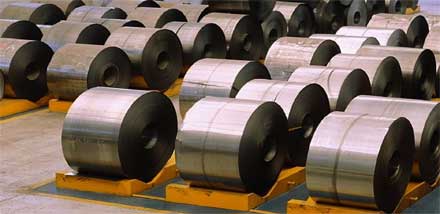Maintaining uniformity is critical in coil coating. Too thin a coating and the customer rejects the coil. Too thick and the manufacturer’s margins are compromised. While many operational characteristics influence the characteristics of the final coat, the viscosity of the coating plays a central role. Improved control of coating viscosity leads to a more uniform application, which in turn increases coating mileage and reduces scrap.

Figure 1: Coated Steel Coils
In order to get a better perspective on the value of improved coating viscosity control, we spoke with Alan Randall, Technical Manager for Coil Coatings at PPG Industries, and Don Wren, an industry consultant.
Spinning at 700 fpm, a 48" web produces about 403,000 in2 of sheet every minute. Alan Randall of PPG indicates that a typical customer might require film thickness of 7.5 msi on the interior and 1.5 msi on the exterior of the coil. This translates to 6,480 grams of coating deposited evenly over this sheet each minute. Assuming the solvent-borne coating has 30% solids and a density of 8.0 lb/gallon, this coater needs 150 gallons of liquid coating every hour.
Unfortunately, hot spinning machinery is an ideal environment for evaporation, and this is a primary source of problems. It is not unusual for coil coaters to experience evaporation losses in the range of 6% of the coating volume, according to Alan. For the typical 48” web, this represents solvent evaporating at a rate of 9.0 gal/hr. This causes the proportion of solids in the coating to rise above targeted levels, and the coating viscosity to thicken in direct proportion.
This evaporation can be made up two ways: adding more coating, or adding make-up solvent. Of the two, adding the appropriate amount of solvent (in this case 9.0 gal/hr.) is the only way to maintain the targeted coating solids in the coating liquid. This can be accomplished by controlling the viscosity level of the coating. Adding the correct amount of make-up fluid to maintain constant viscosity not only enables quality targets to be held, but also saves the coater money, since solvent is less expensive than coating. Assuming a $4.00 differential between the coating and solvent, replacing the evaporated solvent with new solvent saves the coater $36 per hour.
At this rate, savings of about $98,000 per year would be realized through controlling coating viscosity on a single 48" coating line running only one 8 hour shift per day.
<< 1 | 2 >>
“In our testing, Cambridge's VISCOpro viscometers stood head and shoulders above the rest. Not only are the Cambridge viscometers small, accurate, and reliable, but they automatically clean themselves during normal operation.”
- Don Wren, industry consultant, speaking about his experience at Doublecote.
Known for innovation in viscosity measurement and control, Cambridge Viscosity specializes in the industry's most accurate, reliable, and easy-to-use viscometers for research laboratories and process environments.
Cambridge Viscosity, Inc.
50 Redfield St, Suite 204
Boston, MA 02122 USA
781 393-6500
Email: Sales@CambridgeViscosity.com